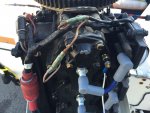sumocomputers
Petty Officer 2nd Class
- Joined
- Feb 23, 2015
- Messages
- 123
Recently installed a Sierra/Teleflex Temp Gauge and Sender Unit (68402P), which just has the gauge for COLD-HOT. I have an '89 Johnson 70.
I wanted a gauge with actual degree numbers, so the local shop sold me a 68401 gauge which goes from 120-240F. Turns out this is really meant for an inboard application.
The sender is installed in one of the threaded bosses near the water jacket, but not past the engine block in any way.
Long story short, now that I have installed a new thermostat, things are much better, but the gauge still reads about 20-25F too high if compared to my IR gun where I measured all over the block. When the gauge reads 180, the block reads around 155F in the hottest places.
Called Sierra, and they said that the sender unit is most accurate when measuring liquid, and will be off when just inserted into only the engine block. They even gave me the resistance values for each temp stage, listed down below. Apparently VeeThree actually makes the gauge, and I havent consulted them yet.
So I have 4 options in order to get a more accurate reading:
1. Figure out a way to install this into the water jacket. I am a little nervous about drilling and tapping into the block, but will do it I have to.
2. Install a resistor or rheostat inline (probably around 25-50 ohms), and target that mid-upper range for correction. Turns out the range is not linear, so adding a resistor in one range will make other parts of the range inaccurate.
3. Buy and Install a different gauge (like one from Faria 13009), who say it will be accurate for this application. Will end up losing money on my original purchase.
4. Put a piece of duct tape and write some numbers on it after getting some correlation data between the gauge and IR gun. <--- I HATE THIS OPTION
Most interested in options 1 or 2, and wondered if anyone has ever done either of these?
Thanks,
Chris
RESISTANCE CHART
120 240 ohm
140 155 ohm
160 100 ohm
180 70 ohm
200 50 ohm
220 40 ohm
240 30 ohm
I wanted a gauge with actual degree numbers, so the local shop sold me a 68401 gauge which goes from 120-240F. Turns out this is really meant for an inboard application.
The sender is installed in one of the threaded bosses near the water jacket, but not past the engine block in any way.
Long story short, now that I have installed a new thermostat, things are much better, but the gauge still reads about 20-25F too high if compared to my IR gun where I measured all over the block. When the gauge reads 180, the block reads around 155F in the hottest places.
Called Sierra, and they said that the sender unit is most accurate when measuring liquid, and will be off when just inserted into only the engine block. They even gave me the resistance values for each temp stage, listed down below. Apparently VeeThree actually makes the gauge, and I havent consulted them yet.
So I have 4 options in order to get a more accurate reading:
1. Figure out a way to install this into the water jacket. I am a little nervous about drilling and tapping into the block, but will do it I have to.
2. Install a resistor or rheostat inline (probably around 25-50 ohms), and target that mid-upper range for correction. Turns out the range is not linear, so adding a resistor in one range will make other parts of the range inaccurate.
3. Buy and Install a different gauge (like one from Faria 13009), who say it will be accurate for this application. Will end up losing money on my original purchase.
4. Put a piece of duct tape and write some numbers on it after getting some correlation data between the gauge and IR gun. <--- I HATE THIS OPTION
Most interested in options 1 or 2, and wondered if anyone has ever done either of these?
Thanks,
Chris
RESISTANCE CHART
120 240 ohm
140 155 ohm
160 100 ohm
180 70 ohm
200 50 ohm
220 40 ohm
240 30 ohm




















